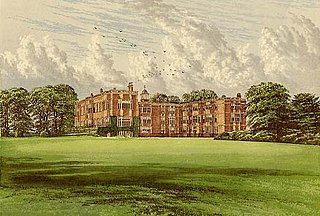
Earl of Essex is a title in the Peerage of England which was first created in the 12th century by King Stephen of England. The title has been recreated eight times from its original inception, beginning with a new first Earl upon each new creation. Possibly the most well-known Earls of Essex were Thomas Cromwell, chief minister to King Henry VIII, and Robert Devereux, 2nd Earl of Essex (1565–1601), a favourite of Queen Elizabeth I who led the Earl of Essex Rebellion in 1601.

Earl of Clarendon is a title that has been created twice in British history, in 1661 and 1776.

Viscount Hereford is the oldest and only extant viscountcy in the Peerage of England, making the holder the Premier Viscount of England. The title was created in 1550 for Walter Devereux, 10th Baron Ferrers of Chartley.

Earl of Drogheda is a title in the Peerage of Ireland. It was created in 1661 for The 3rd Viscount Moore.
This is a list of people who have served as Lord Lieutenant for the East Riding of Yorkshire. The office was established after the English Restoration in 1660, when a Lord Lieutenant was appointed for each Riding of Yorkshire. Since 1721, all Lord Lieutenants have also been Custos Rotulorum of the East Riding of Yorkshire, and for part of the period also Lieutenants of the Town and County of the Town of Kingston upon Hull. It was abolished on 31 March 1974 with the creation of the county of Humberside, but was re-created upon the abolition of Humberside on 1 April 1996.
Robert Montagu, 3rd Earl of Manchester JP was an English courtier and politician who sat in the House of Commons from 1660 to 1671 when he inherited the peerage as Earl of Manchester.

Anne, Viscountess Irvine, was a British court official. She was a poet and close friend of Horace Walpole.
Arthur Ingram, 3rd Viscount of Irvine was an English Member of Parliament and peer. He was the Vice-Admiral of Yorkshire and Member of Parliament for Yorkshire and Scarborough. He was the father or grandfather of all the later Viscounts Irvine.

John Charles Ramsden was a British Whig politician from Newby Park in Yorkshire. He sat in the House of Commons between 1812 and 1836.

Charles Ingram, 9th Viscount of Irvine, known as Charles Ingram until 1763, was a British landowner, politician and courtier. He succeeded his uncle to the Viscountcy and the Temple Newsam estate in Leeds in 1763.
Colonel Rich Ingram, 5th Viscount of Irvine, was an English peer and politician.
Arthur Ingram, 6th Viscount of Irvine, styled the Honourable Arthur Ingram until 1721, was a British landowner and politician who sat in the House of Commons from 1715 until 1721 when he succeeded to the peerage as Viscount Irvine.

Henry Ingram, 7th Viscount of Irvine, styled The Honourable Henry Ingram until 1736, was an English landowner and politician.
Colonel the Honourable Charles Ingram, was a British soldier and politician.
Ingram or Ingrams is a surname, from the given name Ingram. Notable people with the surname include:
John Machell (1637–1704) was for twenty years Member of Parliament for Horsham, Sussex, during the reigns of Charles II, James II and William III and Mary II. By the marriage of his daughter Isabella Machell (1670–1764) to Arthur Ingram, 3rd Viscount of Irvine, he became the grandfather of the fourth, fifth, sixth, seventh and eighth Viscounts of Irvine, and great-grandfather of the ninth, seated at Temple Newsam near Leeds, whose family inherited and augmented his valuable property of Hills house at Horsham, and continued the parliamentary tradition there.
Sir John Ramsden, 4th Baronet was an English landowner and Member of Parliament.
Henry Ingram (1640–1666) was the first to hold the title Lord Ingram, and Viscount Irvine, in the Peerage of Scotland, which in English sources is usually written Viscount Irwin. The Viscountcy existed in four generations of his family before becoming extinct: the seat was at Temple Newsam near Leeds, in Yorkshire.
George Ingram, 8th Viscount Irvine (1694-1763) was an English clergyman and peer in the Peerage of Scotland. His occupation of the Viscountcy was brief, from 1761 to 1763. He was Chaplain to the Speaker of the House of Commons.
Sir John Cole, 1st Baronet was an Anglo-Irish politician. He was the second son of Sir William Cole, a key figure in the Plantation of Ulster, and his second wife Catherine Parsons, daughter of Sir Lawrence Parsons of Birr Castle, Baron of the Court of Exchequer (Ireland) and Anne Malham. William was a Londoner, the only son of Emmanuel Cole, from a family which originated in Devon. Sir Arthur Ingram, the investor, landowner and politician was a cousin through William's mother, Margaret Ingram. John's elder brother Michael was the ancestor of the Earl of Enniskillen.








